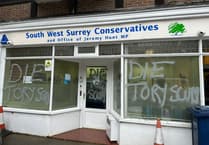WHILE temperatures have been unseasonably mild just lately, this week’s Peeps into the Past looks at when winters were so cold the Basingstoke Canal froze over by the Wheatsheaf Bridge in Woking and people took to the ice.
The date of the picture postcard shown here is around 1912. However, there was also a cold snap in Woking in 1901, with a thick covering of ice on the canal resulting in people skating on it.
In November 1924, winter arrived with frost and fog. By the end of the month snow had fallen – and in December, there were expectations of a white Christmas.
However, in January 1925 there was a dramatic change, with mild south-westerly winds. And with the snow melting, along came flooding.
There were floods in Old Woking as the picture shows, with a car being driven through the floodwaters on what appears to be a very gloomy day.
On the night of 25 January 1925, the River Wey burst its banks at Guildford and rose five feet, flooding the lower part of the town centre. It wouldn’t have been long before the swollen river caused flooding further downstream between Send and Old Woking.
The winter of 1939-40 was the coldest it had been for 45 years. During the latter part of December 1939 an anticyclone over Britain brought frosts and fog at night. In January 1940, after a brief spell of warmer weather, it grew cold again and snow fell around the 10th of the month.
It became so cold that the River Thames froze for eight miles between Sunbury and Teddington.
The very harsh winter of 1947 is still remembered today by those who experienced it. During the first week of January, winds blew in from the east, bringing a period of snow and ice that lasted almost until March.
But some people in Woking enjoyed the winter wonderland.

The News & Mail of 7 February reported: “No one has enjoyed Woking’s freeze-up and snowfalls more than the juvenile members of the community, who have had their best fun for years with snowball battles and [playing] on the ice on the canals and ponds.”
The article was accompanied by a photo of “a small band of enthusiasts sliding on the Basingstoke Canal”.
However, the report added: “Sunday’s thaw caused a break in this pastime, but the youngsters were on the canal again by Wednesday morning, with the return of the ice and snow.”
The next big freeze arrived on Boxing Day 1962, when the first flakes of snow fell and it snowed every day for 10 days. Did anyone predict that night that winter snow would be lying until early March 1963?
A thick blanket of snow was everywhere. Country lanes became blocked by drifts, and on the railways there were serious disruptions with frozen points and conductor rails choked by snow.
Radiators of buses and lorries split as diesel oil froze. Plumbers had their work cut out calling on countless homes with frozen water pipes. The work involved crawling around extremely cold roof spaces, thawing out the pipes with a blow-lamp.
The sexton at St Mary’s Church in Worplesdon had to pick-axe his way through five inches of frozen soil before he could dig graves. The pile of soil from each hole then froze solid and could not be easily replaced after the burials.
If any readers have photos from the winter of 1962-63, we would very much like to see them.
Thanks go to Mark Coxhead for the old postcard of people on the canal at Woking.
If you have some memories or old pictures relating to the Woking area, call David Rose on 01483 838960, or drop a line to the News & Mail.
David Rose is a local historian and writer who specialises in what he calls “the history within living memory” of people, places and events in the west Surrey area covering towns such as Woking and Guildford. He collects old photos and memorabilia relating to the area and the subject, and regularly gives illustrated local history talks to groups and societies. For enquiries and bookings please phone or email him at: [email protected]




